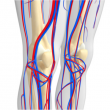The combination of optimal medical treatment plus angioplasty plus supervised exercise seems to be the first line of treatment for patients with intermittent claudication, in terms of maximum walking distance and best quality of life. This combination requires a multidisciplinary team for the best possible results. The aim of this study was to conduct a<a href="https://solaci.org/en/2019/07/23/supervised-exercise-and-revascularization-for-intermittent-claudication/" title="Read more" >...</a>
Improved Outcomes after Lower Limb Revascularization
Operator ability combined with improved and diverse devices for lower limb revascularization has clearly increased in the last decade. However, is this technical feasibility we did not use to have translating into better clinical outcomes for patients, or is it simply inflating our interventionist egos? This study aims at answering the question above by identifying<a href="https://solaci.org/en/2019/07/09/improved-outcomes-after-lower-limb-revascularization/" title="Read more" >...</a>
Staged Complete Revascularization vs. Culprit Vessel PCI at Long-Term
Staged complete revascularization in patients with acute myocardial infarction and multivessel coronary disease is superior to culprit PCI only at five-year follow-up. The outcomes of this retrospective analysis show the benefit of staged PCI, though it might be attenuated in diabetic patients. Outcomes are consistent with previously published randomized studies. Nevertheless, we should remain cautious<a href="https://solaci.org/en/2019/05/22/staged-complete-revascularization-vs-culprit-vessel-pci-at-long-term/" title="Read more" >...</a>
Revascularization in Patients with Multivessel Disease, Diabetes, and Kidney Disease
According to this new study, in patients with coronary disease, diabetes, and chronic kidney disease who underwent revascularization through angioplasty or surgery, events are similar. This is one of the first studies painting the real picture for the prognosis of patients revascularized in these conditions (diabetes plus chronic kidney disease). At first sight, these<a href="https://solaci.org/en/2019/03/04/revascularization-in-patients-with-multivessel-disease-diabetes-and-kidney-disease/" title="Read more" >...</a>
Optimal Revascularization Time in Transient STEMI
Patients admitted with transient ST elevation MI and later normalize completely (symptimos disappear before being treated) are those we normally say are “undergoing a non-ST elevation MI”. This is complex, because revascularization time remains nuclear, as is whether to treat them as STEMI or non-STEMI patients. The aim of this study was to determine the<a href="https://solaci.org/en/2019/01/31/optimal-revascularization-time-in-transient-stemi/" title="Read more" >...</a>
The “Ten Commandments” of Myocardial Revascularization According to Europe
The new European guidelines on myocardial revascularization were developed by a joint effort of the European Society of Cardiology (ESC) and the European Association of Cardiovascular Surgery (EACTS). These guidelines are intended to support clinical practice with pragmatic recommendations based on currently available evidence and on personal experience, whenever evidence is missing. Both coronary angioplasty<a href="https://solaci.org/en/2019/01/24/the-ten-commandments-of-myocardial-revascularization-according-to-europe/" title="Read more" >...</a>
AHA 2018 | Endoscopic Saphenous-Vein-Graft Harvesting in Patients Undergoing Myocardial Revascularization Surgery
For patients undergoing myocardial revascularization surgery, endoscopic harvesting of saphenous veins in expert hands is similar to traditional methods in terms of events, according to this study presented at the American Heart Association (AHA) Congress and published simultaneously in the New England Journal of Medicine (NEJM). This study, called REGROUP, was able to demonstrate that<a href="https://solaci.org/en/2018/11/28/aha-2018-endoscopic-saphenous-vein-graft-harvesting-in-patients-undergoing-myocardial-revascularization-surgery/" title="Read more" >...</a>
Myocardial Revascularization Surgery Hits a Plateau
Hopes were raised high by the ARTS study, when set to show the benefit of bilateral internal mammary arteries (BIMA) during coronary artery bypass graft surgery compared over the use of a single internal mammary artery (SIMA) at 10 year follow up, but only one sub-study was able to show an advantage over radial grafts.<a href="https://solaci.org/en/2018/11/07/myocardial-revascularization-surgery-hits-a-plateau/" title="Read more" >...</a>
Complete Revascularization Improves Long-Term Prognosis in Acute Coronary Syndromes
Going beyond the culprit artery during angioplasty was associated with lower mortality, although this was a cohort study that should be confirmed through randomized trials. According to this new observational study, patients experiencing non-ST-segment elevation myocardial infarction with multivessel disease seem to benefit from complete revascularization during initial angioplasty. This study, published online before<a href="https://solaci.org/en/2018/11/01/complete-revascularization-improves-long-term-prognosis-in-acute-coronary-syndromes/" title="Read more" >...</a>
Mortality in Peripheral Vascular Disease Drops Due to Revascularization
This cohort study shows that, from 2006 to 2015, the overall survival rate increased and the risk of major amputation decreased following lower limb revascularization. These population observations indicate that outcomes after lower limb revascularization have improved during the assessed period, and so have the centralization and specialization of interventional services. The availability and diversity<a href="https://solaci.org/en/2018/08/22/mortality-in-peripheral-vascular-disease-drops-due-to-revascularization/" title="Read more" >...</a>









